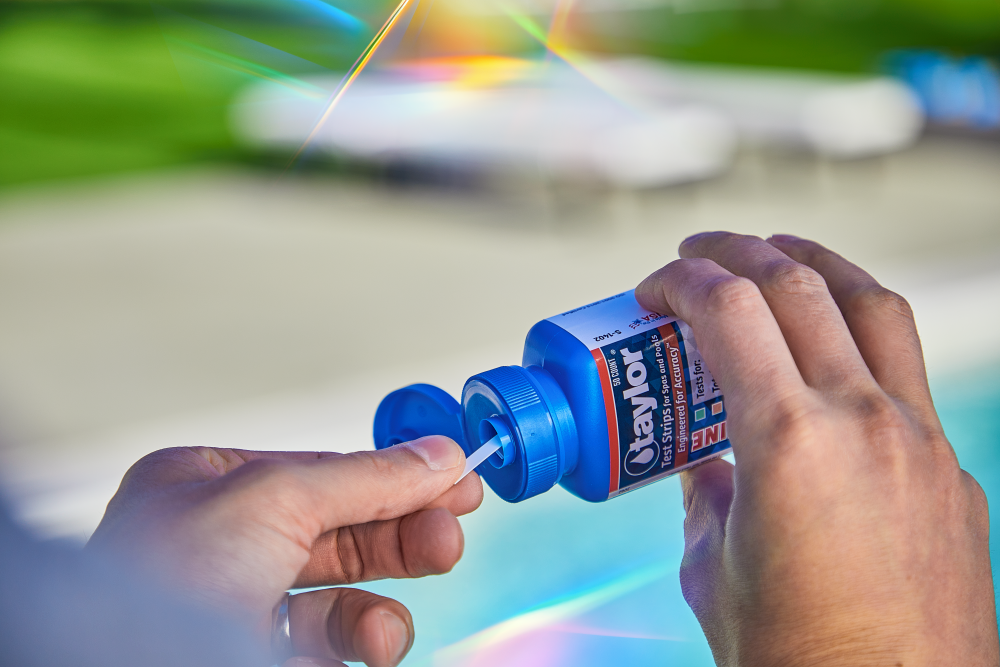Over the years, there have been a lot of myths “floating around” about water testing and maintenance. Common misconceptions can sometimes get in the way of reality and may keep you from taking proper care of your pool or spa. This article helps set the record straight by separating fact from fiction.
Myth: With experience, you should be able to spot water quality issues by simply looking at the water.
Reality: While cloudy water or water that’s discolored from dissolved metals or an algae bloom do signal trouble, the goal of regular water testing is to catch issues before the water gets to one of these extremes. Without routine water testing, water that’s inadequately sanitized may not be detected in time to protect swimmers from harmful microbes and unbalanced water may not be discovered in time to protect surfaces and equipment from damage.
Myth: When it comes to water testing and treatment, a spa is basically the same as a small pool.
Reality: Spas and hot tubs are unique for many reasons — including warmer water temperatures, smaller water volumes, jetted water and a higher bather load. It’s important to take these things into consideration when establishing a routine for proper testing, treating and cleaning. These insights also help explain why regulations regarding water testing and disinfection for public spas are even more stringent than those for public pools.

Myth: Test strips are so easy to use that you don’t need to worry about instructions or technique.
Reality: Yes, test strips are the simplest testing device available, but it’s still important to read and follow the instructions, use the specific techniques recommended by the manufacturer, and observe any precautions and storage guidelines. Here are some important reminders for using test strips:
-
Limit exposure to air
-
Keep strips dry before use
-
Don’t touch the pads (where reagent is embedded)
-
Don’t shake or flick off excess water
-
Let the correct amount of time elapse for starting and completing the readings
-
Read test values in the order specified
-
When comparing colors, hold the strip horizontal to the ground so reagents don’t run between pads
-
For best results, match colors in bright daylight conditions, but avoid direct sunlight, shadows or glare
-
Discontinue use of test strips after their “best by” date
Myth: Water samples can be collected from any location in the pool.
Reality: It’s important to collect a sample of water that is representative of the entire pool or spa. Samples should not be collected from the surface where water interacts with the atmosphere and can carry debris and oils. You should also refrain from collecting water samples near a return line, chemical feeders or near steps, ledges and corners as these areas are also subject to special conditions. Samples should be collected at “elbow depth”—approximately 18” below the surface.
Myth: You can read test results wherever is most convenient — indoors or outdoors.
Reality: Since artificial lighting can skew your color perception, water test manufacturers recommend performing color-matching tests outdoors in natural light. But it’s also recommended that you should not be wearing sunglasses or looking directly into the sun and you should avoid shadows or glare. Daylight simulators are available for purchase to help when color matching must be performed indoors. Many professional testing stations have daylight simulators built in.
Myth: A strong “chlorine” odor and complaints about red eyes and itchy skin mean too much sanitizer has been applied.
Reality: The real culprit here is chloramines (combined chlorine). To reduce unpleasant chloramines, the water actually needs to have more chlorine added — up to the so-called “breakpoint level.” Breakpoint chlorination can be achieved by raising the free chlorine level to 10 times the measured combined chlorine level. It is important to carry out this treatment all at once to prevent the problem from getting worse. Superchlorinating a pool this way will also oxidize any organic matter, resulting in clear water. This procedure is best performed in the evening to minimize chlorine destruction by sunlight.
Myth: For testing chlorine, OT solutions are more reliable than DPD reagents.
Reality: This myth likely started because OT solutions have a longer shelf life than liquid DPD reagents. However, OT tests can only read total chlorine levels. DPD tests are superior because they make the important distinction between free chlorine and combined chlorine. DPD can be used for testing any form of chlorine (including salt chlorinated pools). Because of this, most local health departments governing public and semi-public facilities will specify that operators must be able to determine free chlorine levels and will cite use of DPD for chlorine testing.
Myth: If you test and maintain your own water, you don’t need the help of a pool professional.
Reality: Just as homeowners value expert guidance from service providers for many aspects of their homes and lives — managing a pool is no different. Since a pool’s water chemistry can change on a daily basis due to usage and the influences of weather, wildlife and the backyard environment, regular water testing is essential. And input from pool professionals can be indispensable — whether from service pros who come to your home to test, treat and perform maintenance, or by visiting a water testing station at a local pool retail store. These skilled specialists can often provide more detailed water analysis and valuable consultation, offering experienced insights regarding water chemistry and conditions specific to your area.

Best practices recommend testing and balancing pool and spa water on a weekly basis to help ensure clear, comfortable water and avoid unbalanced water chemistry that could cause damage to pool surfaces and equipment. Test more frequently following events that could impact your pool or spa — including anything from weather events to pool parties. In addition, it’s important to have your water tested professionally at least three times per year to make sure there aren’t any underlying issues that have not been previously detected.

